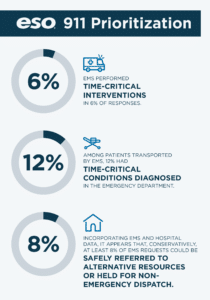Is this 911 call truly an emergency? ESO Research looks at dispatch protocols and patient outcomes to understand 911 prioritization measures
May 22, 2024 – AUSTIN, Texas – ESO, a leading data and software company serving emergency medical services (EMS), fire departments, hospitals, state and federal agencies, recently collaborated with eight EMS Systems and their dispatch centers to examine 911 prioritization systems. With increasing call volumes and limited resources, it is critical for EMS agencies to understand when a call can be safely held in a queue for response versus when a call requires immediate dispatch of an ambulance. This study represents a significant step in improving emergency response amid rising call volume and resource constraints, including workforce shortages.
Data for this research was sourced from the electronic health records of the participating EMS agencies. These agencies also receive patient outcome data from nearby hospital systems through ESO’s Health Data Exchange technology.

Researchers looked at more than half a million 911 responses matched to hospital outcomes. Time-critical incidents requiring immediate ambulance response were defined by evaluating EMS interventions and the patient’s emergency department diagnoses. Researchers analyzed the data from two different perspectives: understanding the type of injury or illness and evaluating the severity of the injury or illness.
Here are some key findings from the data:
- EMS Performed time-critical interventions in 6% of responses.
- Among patients transported by EMS, 12% had time-critical conditions diagnosed in the emergency department.
- Incorporating EMS and hospital data, it appears that, conservatively, at least 8% of EMS requests could be safely referred to alternative resources or held for non-emergent dispatch.
- In some cases, the type of injury or illness was more predictive than the assigned acuity level. Regardless of acuity, those with “Heart Problems,” and “Allergic Reaction” were more likely to have a time-critical condition, while dispatches for “Sick Person” were far less likely to have a time-critical condition.
Research Partners:
- Johns-Hopkins University, Baltimore, MD
- Austin-Travis County EMS, Austin, TX
- Office of the Medical Director, Metropolitan Oklahoma City and Tulsa, OK
- Charleston County EMS, Charleston, SC
- Johnston County EMS, Smithfield, NC
- Guilford County EMS, Greensboro, NC
- Office of the Medical Director, Johnson County EMS System, Olathe, KS
- Lee County EMS, Fort Myers, FL
- Wake County EMS, Raleigh, NC
The results from this study support programs like the one that Austin-Travis County EMS launched shortly after COVID-19, which is an initiative used every day, especially during peak response times.
“In Austin-Travis County, we’ve established the Collaborative Care Communications Center (C4) field triage program, which focuses on handling low-acuity calls without the need for ambulance or hospital services. Through this program, we analyze call patterns, especially during peak times like busy weekends, to effectively manage resources,” explained Heidi Abraham, Chief Deputy Medical Director for Austin Travis County EMS.
“By validating our data through ESO, we are confident that our expanded triage program aligns with the study findings, demonstrating our ability to address low acuity calls with the right patient-centered resources,” continued Dr. Abraham.
The full research paper detailing the methodology, key findings and implications for EMS practice is publicly available. To request the research, visit: https://www.eso.com/data-and-research/.
About ESO
ESO (ESO Solutions, Inc.) is dedicated to improving community health and safety through the power of data. Since its founding in 2004, the company continues to pioneer innovative, user-friendly software to meet the changing needs of today’s EMS agencies, fire departments, hospitals, state and federal offices. ESO currently serves thousands of customers throughout North America with a broad software portfolio, including the industry-leading ESO Electronic Health Record (EHR), the next generation ePCR; ESO Health Data Exchange (HDE), the first-of-its-kind healthcare interoperability platform; ESO Fire RMS, the modern fire Record Management System; ESO Patient Registry (trauma, burn and stroke registry software); and ESO State Repository. ESO is headquartered in Austin, Texas. For more information, visit www.eso.com.
About Austin Travis County EMS:
Austin-Travis County EMS provides 9-1-1 emergency medical response to the citizens of Austin and Travis County serving a population of over 2.2M citizens in a service region of over 1,039 square miles. While most of the assistance we give to the community is medical in nature, the smallest part of what we do involves truly time-critical life-threatening emergencies. Yet everything we do is about service: service to our patients, their families and loved ones; service to our community; and service to the people who make up Austin-Travis County Emergency Medical Services.
Media Contact ESO:
Kaitlyn Karmout
Media Contact Austin-Travis County EMS:
Christa Stedman